How To Grow And Care For Peony
The key to beautiful blooms is planning ahead of time.
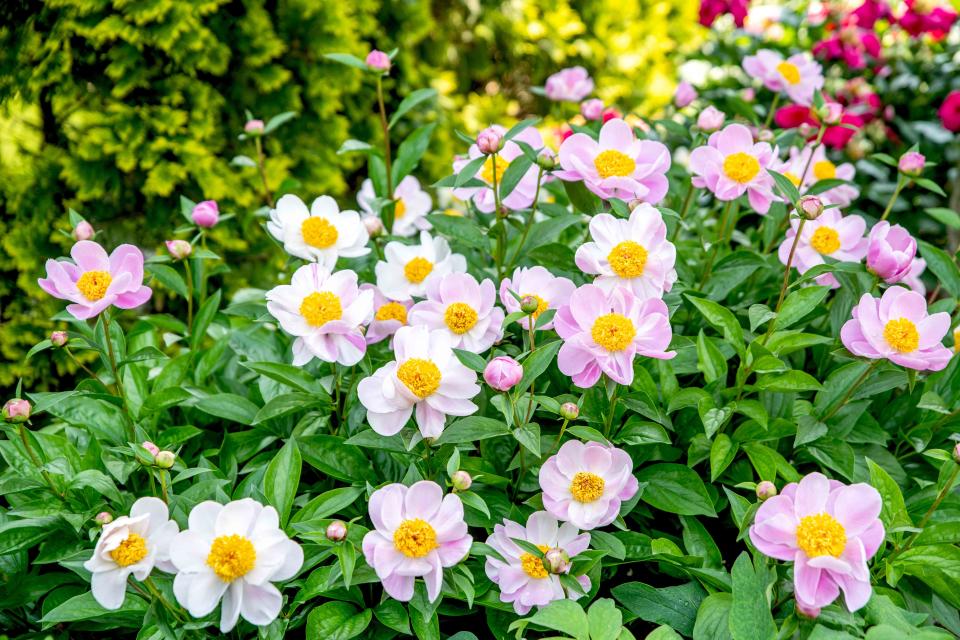
Peonies are a spring garden staple. Southerners usually expect the shrubs to come alive with pops of pastel petals around Mother's Day. Disclaimer: These beauty queens are anything but low-maintenance. Planting peonies require planning and patience. Most peonies flourish in areas with long, cold winters, leading home gardeners to the mistaken conclusion that they’re not suitable for the South. But while it’s true that peonies do generally perform best in the Upper and Middle South, quite a few tolerate the mild winters and hot summers of the Lower South, blooming as far south as Jackson, Mississippi; Montgomery, Alabama; and Columbus, Georgia.
The two basic types are herbaceous peonies, which die to the ground in late fall, and tree peonies (really shrubs), which form woody trunks. Both are from Chinese species: herbaceous peo- nies are chiefly from P. lactiflora, tree types from P. suffruticosa. Most garden peonies are hybrids. Herbaceous peonies are best planted in fall or earliest spring, as bare-root plants consisting of compact rhizomes with thick, fleshy roots and several “eyes” (or growth buds). Tree peonies, nearly all of which are grafted onto herbaceous peony roots, may also be purchased bare-root and planted in fall or spring. However, many growers offer container-grown tree peonies that can be set out at any time the ground isn’t frozen.
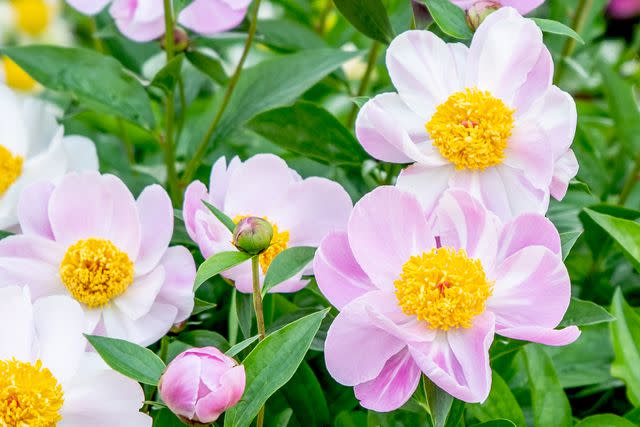
Southern Living/Adrienne Legault
While you can plant many spring-blooming flowers in beds after the last frost of the season, you should wait to plant peonies way ahead of time in the fall. (Peonies won't tolerate procrastinating gardeners. For the last-minute spring planters, don't sleep on these showstoppers.) Peonies thrive in spring when planted in the ground during a cold winter. Peonies are generally not considered invasive, as it takes careful planning and maintenance for these flowers to bloom.
You’ll find beautiful peonies blooming in late spring— they’re great companions for iris, old roses, poppies (Papaver), dianthus, and early daylilies (Hemerocallis). Remember that they grow to a good size over time and may get too big for a small border. When the site is properly prepared and plants are carefully selected and given proper care, the peony will add beauty to your garden for as long as you live.
Plant Attributes
Common Name | Peony |
Botanical Name | Paeonia |
Family | Paeoniaceae |
Plant Type | Perennial, Shrub |
Mature Size | 36 in. tall, 36 in. wide |
Sun Exposure | Full |
Soil Type | Well-drained, loamy |
Soil pH | Acidic |
Bloom Time | Spring |
Flower Color | Red, Pink, Yellow, White |
Hardiness Zones | Zones 6-8 (USDA) |
Native Area | North America, Europe, Asia |
Toxicity |
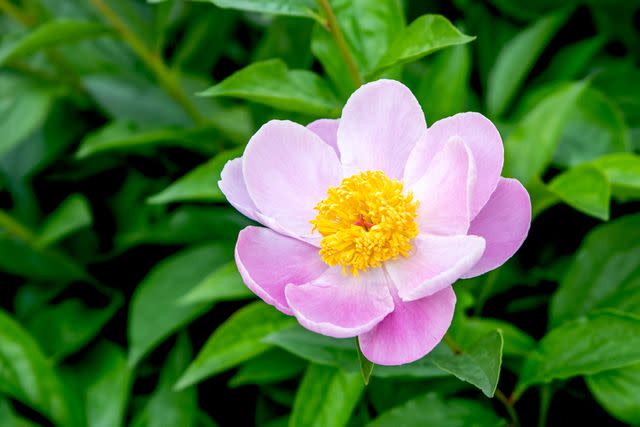
Southern Living/Adrienne Legault
Peony Care
Because peony plants live for decades, they should be considered a permanent addition to your landscape, not unlike planting a tree. Proper planting will ensure flowers for years to come. When planting, position herbaceous peony roots so that the eyes are exactly 1 inch below the soil surface. Deeper planting may reduce flowering. Make sure each rhizome has at least three eyes. Rhizomes with fewer eyes take a long time to bloom. Set tree peonies so that the graft line is 3–4 inches below the soil surface (the object is to get the shrubby top to root on its own). Mulch peonies in spring to cool the roots and retain soil moisture. Plants usually don’t bloom the first year, so be patient.
Light
Choose a site in full sun, a minimum of 6 hours a day, or light afternoon shade in the Lower South. In the hottest climates, peony needs afternoon shade. Peonies are more susceptible to fungal diseases without proper sunlight and may produce few or less impressive blooms.
Soil
Choose a sunny, well-drained spot free from competing roots of nearby trees and shrubs. Don't plant peonies in a wet area. Be sure the soil is well-draining and has a slightly acidic or neutral pH. (Tree peonies prefer somewhat more alkaline soil.) Plant in an area rich with organic matter, or amend your soil with the proper nutrients to help set these flowers up for success.
For each rhizome, dig an area 1/12–2 ft. wide, loosening and turning the soil to a depth of at least 1 ft. Work in copious amounts of organic matter—such as garden compost, composted manure, or chopped leaves—to which you’ve added a cup of super-phosphate.
Water
Peony requires regular water, so water deeply and thoroughly every 10 days or so. This will help the plant become established with a deep and healthy root system. After the peony is established, they are drought-resistant.
Temperature and Humidity
Peonies need a period of cold weather to induce dormancy. Also, peonies bloom best in areas that don't have too much humidity or heat during the blooming season. These flowers bloom early in temperatures with the extended summer heat.
Fertilizer
Peonies should bloom every year after their first season if fertilized twice annually. Feed plants with a low-nitrogen fertilizer, such as 5-10-10. Spread about ½ cup about mature plants in spring when the shoots are beginning to emerge. Reduce the amount to ¼ cup around new, young plants. Repeat in the fall. Alternatively, top dress with an inch of compost in spring before mulching and repeat in the fall. If the plant has nutrient deficiency, apply fertilizer.
Types of Peonies
In the South, early-blooming peonies tend to outperform those that flower late—but all the selections listed below are proven performers in our region. If you have room for only one peony, choose ‘Festiva Maxima’ (double white flowers with red flecks), a Southern heirloom plant that blooms dependably throughout our region. Other recommended selections include the following.
‘Belle Center’: Early semidouble. Deep, mahogany-red blossoms with yellow stamens. To 30 in.
‘Belvidere Princess’: Mid to late semidouble. Lightly fragrant, soft pink. To 28 in.
‘Big Ben’: Early double. Fra- grant, dark red blooms. To 38 in. tall and wide.
‘Do Tell’: Midseason Japanese type. Pink outer petals surround rose-pink and red staminodes. To 34 in.
‘Edulis Superba’: Very early double. Fragrant, rose-pink blossoms. Very floriferous; good cut flower. To 36 in.
‘Félix Crousse’: Late double. Fragrant, ruby-red blossoms. Very floriferous; superb cut flower. To 34 in.
‘Karl Rosenfield’: Midseason double. Mildly fragrant, velvety crimson flowers. Floriferous; great cut flower. To 36 in.
‘Kelway’s Glorious’: Midseason double. Huge, very fragrant, white flowers with creamy centers. Strong stems; very floriferous. To 34 in.
‘Krinkled White’: Early, single. White with yellow stamens. To 32 in. Good cut flowers.
‘Lake of Silver’: Midseason double. Pink that fades to silver on edge. To 34 in. Heat tolerant.
‘Magenta Gem’: Midseason semidouble. Strong pink. To 24 in. tall and 36 in. wide.
‘Minnie Shaylor’: Midseason semidouble. Light pink blossoms fade to pure white. Blooms over a long period. To 36 in.
‘Monsieur Jules Elie’: Midseason double. Giant-size, moderately fragrant blossoms in light pink shading to deeper rose. Good cut flowers. To 36 in.
‘Mrs. Franklin D. Roosevelt’: Midseason double. Fragrant blossoms with shell-pink outer petals surrounding a peach-colored center. Floriferous; excellent cut flower. Vigorous grower to 34 in.
‘Nippon Beauty’: Late Japanese type. Deep garnet blooms with gold-tipped staminodes. Floriferous and vigorous. To 38 in.
‘Philippe Rivoire’: Midseason double. Fragrant, deep crimson blossoms. Good cut flowers. To 30 in.
'Sarah Bernhardt’: Midseason double. Fragrant, rose-pink blossoms with silver-edged petals. Very reliable. Excellent cut flowers. To 34 in.
‘Shirley Temple’: Very early double. Very fragrant, pale pink blossoms age to blush white. Floriferous and vigorous. To 34 in.
Our Favorite Peonies That Thrive In The South
Here is a selection of some of our favorite peony varieties that grow well in the South:
'Festiva Maxima': Red-flecked white blossoms that are Southern favorites.
'Coral Charm': An early-blooming peony producing notably large flowers.
'Kansas': Long-blooming, a reliable selection that thrives in full sun.
'Bartzella': Heat tolerant with a long season of vibrant flowers.
'Rimpo': A tree peony with red petals encircling showy gold stamens.
'Elsa Sass': Intensely fragrant flowers that come late in the season.
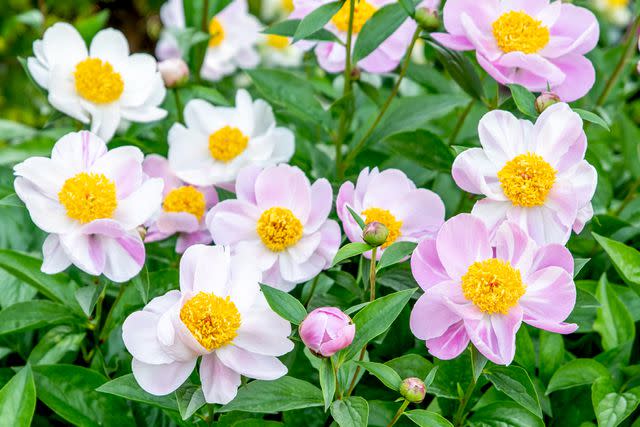
Southern Living/Adrienne Legault
Tree Peonies
Deciduous shrubs. Slow growth to 3–5 ft. tall and eventually as wide, with handsome, blue-green to bronzy green, divided leaves. Single to double, typically very large flow- ers (to 10–12 in.) appear in spring. These peonies seldom show their full potential until they have spent several years in your garden, but the spectacular results are worth the wait. Small, recently grafted, packaged plants are sometimes available, usually sold only by color (red, pink, white, yellow, purple). These are a good buy if you are patient—they’ll take two or three years longer to reach flowering size than older, container-grown or field-grown plants costing much more.
Catalogs offer named selections of Japanese origin in white and shades of pink, red, and purple; blossoms are generally semidouble. More recent and more expensive are orange, yellow, and copper-colored hybrids resulting from crosses of P. suffruticosa with P. delavayi and P. lutea; these bear semidouble blooms that face outward and upward.
Tree peonies require less winter chill than herbaceous peonies. The large flowers are fragile and should be sheltered from strong winds. Prune only to remove faded flowers and any dead wood.
Itoh Peonies
Itoh, or inter- sectional peonies, are crosses between herbaceous peonies and tree peonies. They behave like herbaceous peonies by going dormant with no stem visible in winter. However, the foliage is recognizable as that of a tree peony. Best of all, they put on a show for as long as six weeks as new buds open and replace the faded blooms. Flowers are huge, like their tree peony parent, but do not need staking. Look for yellow ‘Bartzella’, in addition to others in shades of pink and coral.
Pruning
Prune peonies after it blooms with clean pruners. Cut dead stems or diseased stems to just below the infected area. Trim branches to maintain the plant's shape, but overall, peonies do not need a lot of pruning. Deadheading flowers also promote new growth, so once the flowers begin to fade, cut back to the ground. Tree peonies require similar pruning, but don't remove the woody part.
Propagating Peonies
Peonies do not need to divide the same as other perennials. However, dividing the root clump is a way to propagate new growth. Wait until the peony is matured (at least three or four years) before dividing. Here is how to propagate peonies by dividing the root:
After peonies are finished blooming for the season, typically in the fall, start by pruning the foliage to the ground.
Next, dig up the root clump. Be mindful not to sever the roots and remove excess dirt.
Gently separate the roots so that each section you plan to plant has at least three "eyes." Cut sections with a clean, sharp knife.
After separating the roots, remove divisions and leave the large, fleshy roots.
Immediately plant the divided roots and the "eyes" one to two inches below the top of the soil. It can take many years before peonies are root-bound and blooming.
How to Grow Peonies From Seed
Plant ripen seeds as soon as they are available—If using dry seeds, plant in the autumn.
Plant seeds a few inches below the top of the soil outdoors in an area that receives at least six hours of sunlight daily. You can also start seeds indoors.
Make sure to mulch soil to keep it warm throughout the winter and to provide the necessary nutrients.
Expect to see sprouts in the spring after planting. Some seeds will take longer than others to be root-bound.
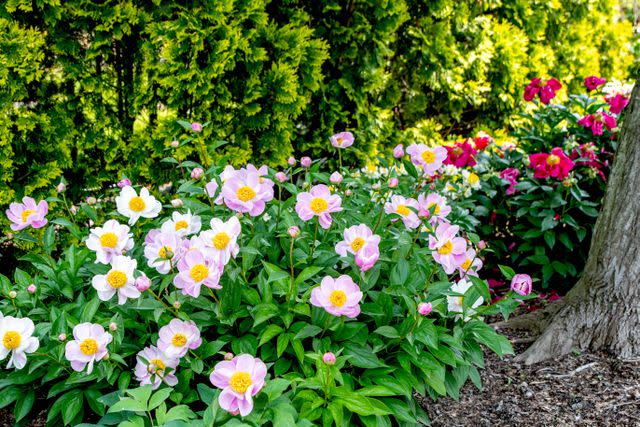
Southern Living/Adrienne Legault
Potting and Repotting Peonies
Peonies need repotting if you purchase them from a garden supplies store or another vendor. Begin by digging a hole at least 30 percent larger than the existing plant. Fill the hole until the "eyes" (growth buds) are about one inch above soil level. Cover the plant with loose organic compost or peat moss soil about two inches above that, and water thoroughly.
You want to space the peony plants at least four feet apart. They need plenty of room to grow. Positioning them too close together could result in leggy plants and disease.
Overwintering
Peonies do not require too much protection from winter's low temperatures. Peonies need around six weeks of cold weather to induce dormancy to replenish and bloom in the spring. To add an extra layer of protection, be sure to prune peonies to the ground after the bloom period. Only remove the foliage and branches. Keep the "eyes" because this is how the peony will grow the following year. Additionally, mulching the roots of younger peony plants can help protect them from the dropping temperatures.
Common Pests & Plant Diseases
Botrytis is a type of fungal rot that impacts peonies' growth. It can infect the leaves and stems, resulting in a black or grey mold growing. Remove the infected areas so it does not spread. If a leaf is wilting or blackening, then it must be removed. This issue usually appears in the spring or during a rainy season when the peony does not have enough time to dry.
Powdery mildew is another fungus that appears on peony leaves. It leaves a white residue on the leaves that can be treated by gently washing the leaves with water or a fungal spray.
In woody peonies, rabbits might attack the branches during the winter. A mesh wiring can prevent animals from eating the wood if necessary.
How to Get Peonies to Bloom
Peonies bloom in the spring or early summer. Deadheading flowers can promote new growth if the blooms begin to fade. Typically, peonies have very showy blooms, so if you do not see the results you want, ensure they receive enough sunlight and water the plant correctly. Competition from surrounding plants can also prevent peonies from blooming.
If poor flowering occurs during its blooming season, it can be that the plant is too deep in the soil or too shallow. To fix this problem, dig up the peony during its dormant season and replant it appropriately.
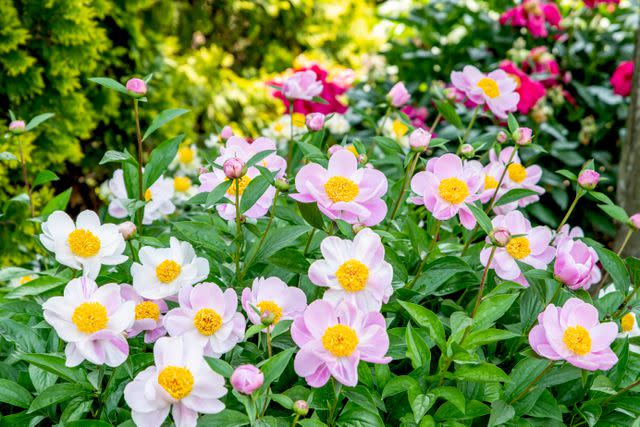
Southern Living/Adrienne Legault
Common Problems With Peonies
Curling Leaves
When peonies have curling leaves, this signifies mismanaged watering or an insect infestation. The soil should be well-drained, and the first two inches of soil should be dry. Protect peonies from strong winds, but plant them in a location where these plants will receive good air circulation. If insects are present, use a horticultural oil to spray on the leaves. Occasionally, peony leaves will curl when exposed to prolonged hot weather, so be sure to water during these times.
Leaves Turning Brown
If you notice peony leaves turning brown or spots start forming, this signifies leaf spots. Leaf spot is a fungal disease, primarily causing superficial damage, but if left untreated can develop into blight. Blight can cause sprouts to fall over or different fungi to grow. At the first sign of disease, treat peonies with a fungicide spray. (Spray to prevent these fungi from forming in early spring).
Shady Location
Solution? Move to a sunnier spot during dormancy.
Young Plants
Patience is a virtue with peonies. Give the plant a year to bloom.
Freeze
If your flower beds were wiped in a late freeze, don't fret right away. Wait until next year to see if the buds survived.
Heavy Blooms
As buds begin to enlarge and grow top heavy, support the stems with subtle wire stakes left over from pruning. Stick them into the soil to support the heavy blooms, especially during spring rains.
Frequently Asked Questions
How long do peonies bloom?
Peony flowering season can vary, but generally expect individual bloom to last seven to 10 days
Where does the name peony come from?
The Greek origins of the name are murky, but according to one theory, the Paeonia genus was named after Paeon, a student of Asclepius, the god of medicine and healing. In Greek mythology, Paeon healed Hades after he was wounded in battle. After a jealous Asclepius threatened to murder Paeon, the gods intervened and transformed the healer into a flower. In ancient times, peonies were also used as medicinal plants.
How many peony species are there?
These 33 species fall into three distinct groups, two of which are cultivated for gardens. One group is known as herbaceous peonies—perennials that bloom in late spring and early summer. The second group is known as tree, or mountain, peonies, which flower in late spring and can be identified by their woody shrub form. The third group of peonies consists of two species that are found in limited areas of the Western United States and are not grown commercially or sold in garden centers.
For more Southern Living news, make sure to sign up for our newsletter!
Read the original article on Southern Living.

